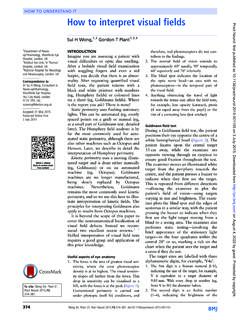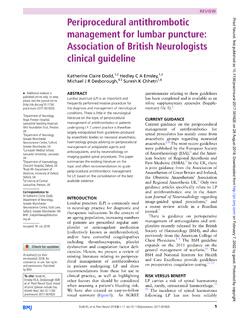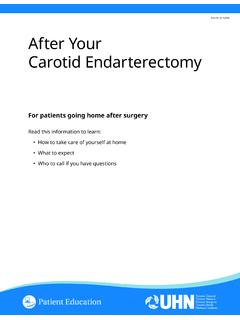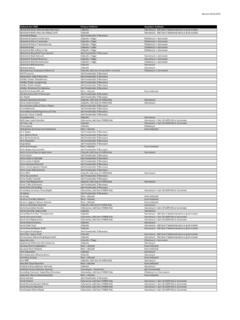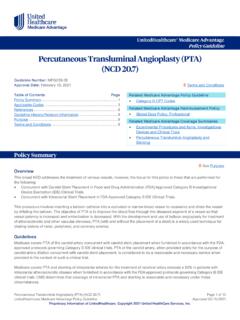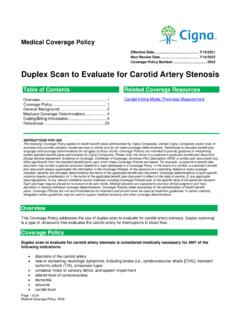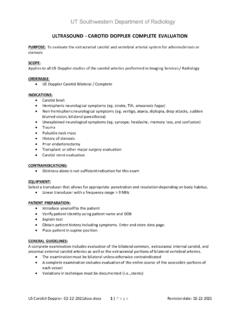Transcription of THE BRUIT THAT MATTERS: THE ONE DUE TO CAROTID …
1 AUGUST 2002221 2002 Blackwell Science LtdINTRODUCTIONWhen faced with a patient who may have had a stroke or transient ischaemic attack (TIA), one needs to ask oneself some simple questions: was the event vascular?; where was the brain lesion, and hence its vascular territory?; what was the cause? A careful history and focused physical examination are essential steps in getting the right answers. Although one can learn a great deal about the state of a patient s arteries from expensive vascular imaging techniques, this does not make simple auscultation of the neck for CAROTID bruits redundant. In this brief review, we will therefore defi ne the place of the BRUIT in the diagnosis and management of patients with suspected TIA or ARE CAROTID BRUITS IMPORTANT?A BRUIT over the CAROTID region is important because it may indicate the presence of athero-sclerotic plaque in the CAROTID arteries.
2 Throm-boembolism from atherosclerotic plaque at the CAROTID artery bifurcation is a major cause of TIA and ischaemic stroke. Plaques occur preferentially at the CAROTID bifurcation, usually fi rst on the posterior wall of the internal CAROTID artery origin. The growth of these plaques and their subsequent disintegration, surface ulcera-tion, and capacity to throw off emboli into the brain and eye determines the pattern of subse-quent symptoms. The presence of an arterial BRUIT arising from stenosis at the origin of the internal CAROTID artery may therefore help to The CAROTID bruitPeter A. G. Sandercock and Eleni KavvadiaDepartment of Clinical Neurosciences, University of Edinburgh, Western General Hospital, Crewe Road, Edinburgh EH4 2XU, UK; Neurology, 2002, 2, 221 224clarify whether an event was vascular or not, identify the cause as likely to be due to athero-matous stenosis, and the possibility that the stenosis may be severe enough to justify CAROTID endarterectomy .
3 However, not all noises in the neck indicate serious arterial disease. So, we need to review: how bruits arise, how to identify arterial bruits, to identify which noises in the neck matter, and what to do once you fi nd an arterial BRUITS ARISEC arotid bruits generally result from turbulent, non-laminar fl ow through a stenotic lesion, which causes arterial wall vibrations distal to the stenosis. The vibrations are transmitted to the body surface, where they can be detected with a stethoscope. A BRUIT can develop when the arterial lumen is reduced to less than 50% of its original cross-sectional TO LISTEN FOR BRUITSB efore you get out your stethoscope to listen for a BRUIT , you need to have a clear idea of what you will do if you fi nd one! Table 1 gives our view of when listening to the neck is likely to be useful in Figure 1 Where to listen for a bifurcation/internal CAROTID artery origin BRUIT high up under the angle of the SIGN 2002 Blackwell Science LtdAUGUST 22106/08/2002, 17:07:21 on January 20, 2022 by guest.
4 Protected by Neurol: first published as on 1 August 2002. Downloaded from PRACTICAL NEUROLOGY222 2002 Blackwell Science Ltdneurological practice. Then, get the patient into a quiet room, in a relaxed and comfortable posi-tion. We use the diaphragm of the stethoscope, because it detects the higher frequency sounds of arterial bruits rather better than the bell. Ask the patient to breathe in and hold their breath. Listen over an area beginning from just behind the upper end of the thyroid cartilage to just below the angle of the jaw, in other words over the line of the common CAROTID artery leading up to the bifurcation into the internal and external CAROTID arteries. Apply only suffi cient pressure to ensure the diaphragm rests squarely on the skin (Fig. 1). Excessive pressure can compress the underlying artery enough to cause a BRUIT even when the artery is BRUIT THAT MATTERS: THE ONE DUE TO CAROTID STENOSISB ruits at the bifurcation of the common CAROTID artery are best heard high up under the angle of the jaw (Fig.)
5 2). At this level the common CAROTID artery bifurcates and gives rise to its internal branch. If one hears a BRUIT only in the base of the neck, or along the course of the common CAROTID artery, it is referred to as diffuse . Diffuse bruits are not a very specifi c indicator of internal CAROTID artery disease. Bruits heard only at the bifurcation are more specifi c for internal CAROTID artery origin stenosis, but lack sensitivity. Un-fortunately bruits at this location can also arise from disease of the external CAROTID NOISES IN THE NECK See Table 2. Bruits transmitted from the heart become attenuated as one moves the stethoscope up the neck towards the angle of the jaw. Thyroid bruits are bilateral and more obviously located over the gland. A hyperdynamic circulation tends to cause a diffuse and bilateral BRUIT .
6 Venous hums are caused by fl ow in the internal jugular vein. They are continuous and roaring and are obliter-ated by light pressure over the ipsilateral jugular vein. These are found in over 25% of young people but can be distinguished from bruits by their dis-appearance with the Valsava manoeuvre. Venous hums are rarely heard with the patient lying down. An arterial BRUIT in the supraclavicular fossa sug-gests either subclavian or proximal vertebral arte-rial disease, but a transmitted BRUIT from aortic stenosis must also be considered. Normal young adults quite often have a short supraclavicular BRUIT ; the reason is OF CAROTID STENOSIS AND CHARACTER OF THE BRUITWith modest arterial stenosis or irregularity, any Situations when the presence or absence of a CAROTID BRUIT can be helpful In patients over 50 years of age with recent CAROTID territory TIA or stroke a BRUIT over the symptomatic CAROTID artery suggests the possibility of an underlying severe stenosis, likely to benefi t from surgery a BRUIT may indicate stroke or TIA is more likely due to atherosclerosis than some other nonatheromatosis pathophysiological process In patients with history of sudden onset of focal neurological signs (transient or persistent)
7 The presence of a BRUIT increases the probability that the symptoms were vascular in origin In younger patients with sudden focal symptoms (transient or persistent) where a vascular cause is thought unlikely ( clinical syndrome of migraine aura without headache) absence of a BRUIT makes underlying vascular disease even less where it may be better not to auscultate the neck Asymptomatic individuals Patients with nonfocal neurological symptoms blackouts dizzy turns headaches Patients with pulsatile tinnitusTable 1 When is neck ausculation clinically useful?Figure 2 The sites of maximal intensity of arterial bruits in the neck. A BRUIT arising from the CAROTID bifurcation is high up under the angle of the jaw. Localized supraclavicular bruits are caused either by subclavian or vertebral origin artery stenosis.
8 Diffuse bruits are transmitted from the arch of the aorta or the 22206/08/2002, 17:07:26 on January 20, 2022 by guest. Protected by Neurol: first published as on 1 August 2002. Downloaded from AUGUST 2002223 2002 Blackwell Science Ltdbruit will be of short duration and heard just in mid-systole. As the degree of stenosis increases, the BRUIT is likely to become more audible and longer, expanding to be pan-systolic. Soft, long duration, high frequency bruits represent haemodynamically-severe stenosis with a large pressure gradient throughout the cardiac cycle. The intensity of the BRUIT correlates with the de-gree of stenosis to some extent. A harsher BRUIT implies greater stenosis, but remember that stenoses of more than 85% may be associated with low fl ow through the CAROTID artery, and hence no audible BRUIT at AND SPECIFICITY OF CAROTID BRUITSHow reliable a sign is a CAROTID BRUIT ?
9 In symp-tomatic patients, Ziegler and colleagues found a sensitivity of only and a specifi city of for detecting stenosis greater than 50% (Ziegler et al. 1971). The collaborators of the North American Symptomatic CAROTID endarterectomy Trial (NASCET) found that a focal CAROTID BRUIT had a sensitivity of 63% and a specifi city of 61% for high-grade stenosis (Sauve et al. 1994). In such patients when bruits were absent, this only low-ered the probability for high-grade stenosis from a pretest value of 52% to a post test probability of 40% (Sauve et al. 1994). When combined with four other clinical characteristics (infarction on CT brain scan, a CAROTID ultrasound scan suggest-ing more than 90% stenosis, a transient ischaemic attack rather than a minor stroke as a qualifying event, and a retinal rather than a hemispheric qualifying event), the predicted probabilities of high-grade stenosis ranged from a low of 18% (when none of the features was present) to a high of 94% (when all the features were present).
10 Hankey and Warlow reported the most favour-able of results, the presence of a BRUIT in patients with a symptomatic internal CAROTID artery had a sensitivity of 76% and a specifi city of 76% for the detection of CAROTID stenosis (defi ed as diameter stenosis of the ICA of 75 99%, as measured by the ECST method) (Hankey & Warlow 1990). So, in the right kind of patients, CAROTID bruits are quite good (but not perfect) at identifying patients with signifi cant stenosis. A good going BRUIT is also a reasonably robust clinical sign. Among 55 patients examined independently by two neurologists (both of whom had normal audiograms), the agreement beyond chance for the presence of a BRUIT was good, with a kappa statistic of (Chambers & Norris 1985).BRUITS IN SYMPTOMATIC PATIENTS WITH SUSPECTED TIA OR ISCHAEMIC STROKEIn general, the presence or absence of a BRUIT is clinically most useful in symptomatic people.

